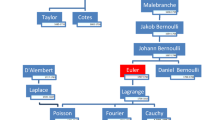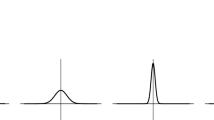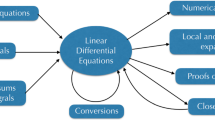Abstract
Diagrams have played an important role throughout the entire history of differential equations. Geometrical intuition, visual thinking, experimentation on diagrams, conceptions of algorithms and instruments to construct these diagrams, heuristic proofs based on diagrams, have interacted with the development of analytical abstract theories. We aim to analyze these interactions during the two centuries the classical theory of differential equations was developed. They are intimately connected to the difficulties faced in defining what the solution of a differential equation is and in describing the global behavior of such a solution.
Similar content being viewed by others
References
Agnesi, M. G. (1748). Instituzioni analitiche ad uso della gioventu’ italiana (Vol. II). Milano: Nella Regia-Ducal Corte.
Andersson K. G. (1994) Poincaré’s discovery of homoclinic points. Archive for History of Exact Sciences 48: 133–147
Archibald, T. (2003). Differential equations: A historical overview to circa 1900. In H. N. Jahnke (Ed.), A history of analysis (pp. 325–353). Providence (Rhode Island): American Mathematical Society.
Arnold V. (1974) Équations différentielles ordinaires. Mir, Moscou
Barrow-Green J. (1997) Poincaré and the three body problem. Providence (Rhode Island), American Mathematical Society
Bernoulli, J. (1694). Modus generalis construendi omnes æquationes differentiales primi gradus. Acta Eruditorum, November, 435–437.
Boole G. (1859) A treatise on differential equations. Macmillan, London
Bos H. J. M. (1988) Tractional motion and the legitimation of transcendental curves. Centaurus 31: 9–62
Bottazzini U. (2000) Poincaré, philosophe et mathématicien. Pour la Science, Paris
Bush V. (1931) The differential analyser. A new machine for solving differential equations. Journal of the Franklin Institute 212: 447–488
Caparrini S. (2006) On the common origin of some of the works on the geometrical interpretation of complex numbers. In: Williams K. (eds) Two cultures. Essays in honour of David Speiser. Birkhauser, Basel, pp 139–151
Carnot L. N. M. (1803) Géométrie de position. Duprat, Paris
Cauchy, A.-L. (1981). \’Equations différentielles ordinaires. Cours inédit (fragment). Paris: Études vivantes; New York: Johnson Reprint Corporation.
Chabert J.-L., Dahan Dalmedico A. (1992) Les idées nouvelles de Poincaré. In: Dahan Dalmedico A., Chabert J.-L., Chemla K. (eds) Chaos et déterminisme. Seuil, Paris
de Bougainville L.-A. (1756) Traité du calcul intégral pour servir de suite à à l’Analyse des infiniment petits de M. le marquis de l’Hopital. Seconde partie. Guérin & Delatour, Paris
de L’Hospital G.-F. (1696) Analyse des infiniments petits pour l’intelligence des lignes courbes. Imprimerie Royale, Paris
Dieudonné J. (1964) Algèbre linéaire et géométrie élémentaire. Hermann, Paris
Dobrovolski V. A. (1972) Sur l’histoire de la classification des points singuliers des équations différentielles. Revue d’histoire des sciences 25: 3–11
Euler, L. (1768–1769). Institutiones calculi integralis (Vols. I, II). Petropoli: Impensis Academiæ Imperialis Scientiarum.
Giaquinto M. (1994) Epistemology of visual thinking in elementary real analysis. The British Journal for the Philosophy of Science 45: 789–813
Gilain C. (1991) La théorie qualitative de Poincaré et le problème de l’intégration des équations différentielles. Cahiers d’histoire et de philosophie des sciences 34: 215–242
Gilain C. (1994) Ordinary differential equations. In: Grattan-Guinness I. (eds) Companion encyclopedia of the history and philosophy of the mathematical sciences. Routledge, London, New York, pp 440–451
Guicciardini N. (1994) Three traditions in the calculus: Newton, Leibniz and Lagrange. In: Grattan-Guinness I. (eds) Companion encyclopedia of the history and philosophy of the mathematical sciences. Routledge, London, New York, pp 308–317
Hill, G. W. (1878). Researches in the lunar theory. American Journal of Mathematics, 1, 5–26, 129–147, 245–260.
Israel G., Menghini M. (1998) The “essential tension” at work in qualitative analysis: A case study of the opposite points of view of Poincaré and Enriques on the relationships between analysis and geometry. Historia Mathematica 25: 379–411
Kolmogorov, A. N., & Yushkevich, A. P. (Eds.). (1998). Mathematics of the 19th century (Vol. 3). Basel: Birkhäuser (Part 2: “Ordinary Differential Equations”, pp. 83–196).
Lacroix S.-F. (1798) Traité du calcul différentiel et du calcul intégral. Duprat, Paris
Lagrange J.-L. (1806) Leçons sur le calcul des fonctions, nouvelle édition revue, corrigée et augmentée par l’Auteur. Courcier, Paris
Laplace, P.-S. (1891–1893). Œuvres complètes (Vols. 8, 9). Paris: Gauthier-Villars.
Lipschitz R. (1880) Lehrbuch der Analysis. II. Differential- und Integral-Rechnung. Cohen, Bonn
Longo G. (1997) Géométrie, mouvement, espace: cognition et mathématiques. Intellectica 25: 195–218
Mancosu P. (2005) Visualization in logic and mathematics. In: Mancosu P., Jorgensen K. F., Pedersen S. A. (eds) Visualization, explanation and reasoning styles in mathematics. Springer, Dordrecht, pp 13–30
Manders K. (2008) The Euclidean diagram (1995). In: Mancosu P. (eds) The philosophy of mathematical practice. Oxford University Press, Oxford, pp 80–133
Manfredi G. (1707) De constructione æquationum differentialium primi gradus. Typis Constantini Pisarri, Bononiæ
Massau, J. (1878–1887). Mémoire sur l’intégration graphique et ses applications. Annales des Ingénieurs Sortis des Écoles Spéciales de Gand, 2, 13–55, 203–281; 7, 53–132; 10, 1–535.
Massau J. (1889) Appendice au mémoire sur l’intégration graphique et ses applications. Annales des Ingénieurs Sortis des Écoles Spéciales de Gand 12: 185–443
Moigno F.-N.-M. (1844) Leçons de calcul différentiel et de calcul intégral rédigées d’après les méthodes et les ouvrages publiés ou inédits de M. A.-L. Cauchy. Bachelier, Paris
Mumma, J. (2008). Ensuring generality in Euclid’s diagrammatic arguments. In G. Stapleton, J. Howse, & J. Lee (Eds.), Diagrammatic representation and inference, 5th international conference, diagrams 2008, Herrsching, Germany, September 19–21, 2008. Dordrecht: Springer.
Mumma, J. (2009). Proofs, pictures, and Euclid. Synthese. doi:10.1007/s11229-009-9509-9.
Painlevé P., Vessiot É. (1910) Équations différentielles ordinaires. In: Molk J. (eds) Encyclopédie des sciences mathématiques pures et appliquées Tome II (Vol 3 fasc 1).. Gauthier-Villars, Paris
Panza, M. (2007). The twofold role of diagrams in Euclid’s plane geometry. Hyper Articles en Ligne. http://hal.archives-ouvertes.fr/hal-00192165/fr/.
Picard, É. (1893–1896). Traité d’analyse (Vols. 2, 3). Paris: Gauthier-Villars.
Poincaré H. (1881) Mémoire sur les courbes définies par une équation différentielle. Journal de Mathématiques pures et Appliquées (3) 7: 375–422
Poincaré H. (1882) Mémoire sur les courbes définies par une équation différentielle. Journal de Mathématiques pures et Appliquées (3) 8: 251–296
Poincaré H. (1885) Mémoire sur les courbes définies par une équation différentielle. Journal de Mathématiques pures et Appliquées (4) 1: 167–244
Poincaré H. (1886) Mémoire sur les courbes définies par une équation différentielle. Journal de Mathématiques pures et Appliquées, (4) 2: 151–217
Poincaré H. (1892) Les méthodes nouvelles de la mécanique céleste. Gauthier-Villars, Paris
Poincaré, H. (1895). Analysis situs. Journal de l’École polytechnique, IIe série, Premier cahier.
Poincaré H. (1899) Les méthodes nouvelles de la mécanique céleste. Gauthier-Villars, Paris
Riccati, V. (1752). Du usu motus tractorii in constructione æquationum différentialium. Bononiæ: Ex Typographia Lælii a Vulpe.
Shin S.-J. (1994) The logical status of diagrams. Cambridge University Press, Cambridge
Tournès D. (2003a) L’intégration graphique des équations différentielles ordinaires. Historia Mathematica 30: 457–493
Tournès D. (2003b) Junius Massau et l’intégration graphique. Revue d’Histoire des Mathématiques 9: 181–252
Tournès D. (2009) La construction tractionnelle des équations différentielles. Blanchard, Paris
Author information
Authors and Affiliations
Corresponding author
Rights and permissions
About this article
Cite this article
Tournès, D. Diagrams in the theory of differential equations (eighteenth to nineteenth centuries). Synthese 186, 257–288 (2012). https://doi.org/10.1007/s11229-012-0069-z
Received:
Accepted:
Published:
Issue Date:
DOI: https://doi.org/10.1007/s11229-012-0069-z




